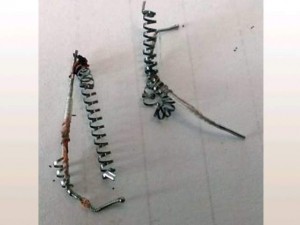Essure removal: what are your options?
Essure was touted as a quick, in-office alternative for permanent birth control when it was approved by the Food and Drug Administration in 2002. Hundreds of thousands of women have received the device since it came on the market 14 years ago, but thousands of women say they regret their decisions.
The tiny metal coils, which are inserted into a woman’s fallopian tube by her doctor in his office without the need for surgery, are reported to cause serious, sometimes life-altering side effects. Women have reported suffering severe pelvic pain, migraines, hair loss, and perforation of the fallopian tubes or uterus, to name just a few.
Some women’s side effects are debilitating, and many opt to have the coils removed in the hope of relieving their adverse symptoms. But what was relatively easy going in is not so easy coming out.
Women who wish to have Essure removed must undergo surgery, sometimes involving a total hysterectomy. Essure removal surgery can be difficult, and a second or third surgery is sometimes necessary to ensure no fragments are left behind.
Essure causes the body to form scar tissue around the coils inside the fallopian tubes. This blocks sperm from reaching the eggs; it also makes it more difficult to remove the device from the body, since they are embedded in the tissue. The coils also break apart easily. Any remaining pieces inside the body after surgery could mean a resurgence of symptoms that are sometimes worse than before.
There are several procedures doctors use to remove Essure devices, and the procedure used is usually dependent upon the woman’s situation. Women should consult with several doctors and choose only the most experience surgeon to remove the devices.
Essure Removal Procedures
Salpingotomy
A Salpingotomy is usually performed as an outpatient procedure and involves cutting the devices out intact from the fallopian tubes. A surgeon cuts a small incision in the abdomen just above the pubic hairline using laparoscopic surgery (a minimally invasive surgical technique). The surgeon then cuts an incision into the fallopian tubes directly above the Essure device and removes it intact.
Possible complications
This surgery must be performed by a specialist with extensive experience as there is risk for fragmentation when removing the device. There are relatively few surgeons who have extensive experience with this procedure.
Total hysterectomy with bilateral salpingectomy
Many women who had the Essure device implanted ended up undergoing a hysterectomy to have it removed. A total hysterectomy involves removing the uterus and cervix. A bilateral salpingectomy involves removing the fallopian tubes, as well.
There are several ways to perform a hysterectomy. Some surgeons choose to perform a laparoscopic hysterectomy, which involves making small incisions in the navel and removing the uterus and other organs through tubes or through the vagina.
Vaginal hysterectomies involve removing the uterus and other organs through the vaginal opening. Abdominal hysterectomies are only performed under special circumstances and involve making a six to eight inch incision in the abdomen through which the uterus and other organs are removed.
Possible complications
Complications after a hysterectomy include pelvic organ prolapse and early menopause. Pelvic organ prolapse occurs when pelvic organs, such as the bladder, fall from their normal place and push against the walls of the vagina. Doctors may recommend inserting a pelvic mesh to help with the prolapse, but these products have been linked to a host of other complications, including degrading of mesh, infection and nerve damage.
Early menopause is also a risk associated with hysterectomies, even if the ovaries remain intact after surgery. Early menopause may bring on a slew of symptoms such as hot flashes, changes in sex drive and mood changes.
A more severe and debilitating side effect of hysterectomies is called Post-Hysterectomy Syndrome. The symptoms usually develop about three to six months after the hysterectomy and gradually get worse.
Post-Hysterectomy Syndrome symptoms include:
- Mood changes
- Anxiety
- Irritability
- Depression
- Lethargy
- Hot flashes
- Night sweats
- Headaches
- Muscle or joint aches
Some doctors may choose to use a power morcellator during a hysterectomy, which cuts up the uterus and makes it easier to remove. Power morcellators have come under scrutiny because they have the potential to spread undiagnosed cancers throughout the abdomen. There have also been reports of doctors cutting up the Essure coils along with the uterus, spreading fragments of metal and PET into the abdomen.
Tubouterine Implantation
Tubouterine implantaion is usually performed as an outpatient procedure. It involves removing the fallopian tubes from the uterus, cutting out the Essure device along with the surrounding scar tissue, and reattaching the fallopian tubes with the uterus. This surgery should be performed by a specialist with years of experience. It may also restore a woman’s fertility so some surgeons may perform a tubal ligation after the Essure device is removed.
Possible complications
When a woman becomes pregnant after undergoing tubouterine implantation, she runs the risk of ectopic pregnancies (when the fertilized egg stays in the fallopian tube) and uterine rupture. Uterine rupture occurs during childbirth and can result in severe loss of blood and is dangerous to both mother and baby.
Choosing the right doctor for Essure removal
It is extremely important to choose a doctor who has experience removing Essure.
National Injury Help neither endorses nor recommends any doctor on this list. It is simply a resource for women seeking options to have their Essure device removed. It is important to seek multiple opinions and to thoroughly vet each doctor before undergoing any type of surgery.

Note: The information provided in this article is based on reports from publicly available sources, including news outlets, police reports, and eyewitness accounts. National Injury Help has not independently verified all details of the reported incident. If you find any inaccurate or outdated information, please contact us, and we will review and update the content as appropriate. The photo used in this post is for illustrative purposes only and does not depict the actual scene of the incident.
Disclaimer: The content of this article is intended for informational purposes only and does not constitute legal advice or establish an attorney-client relationship with National Injury Help. For legal assistance specific to your case, we encourage you to contact a qualified attorney.
Free Case Evaluation
Contact Us today for a FREE, Immediate Case Evaluation
Contact Us today for a FREE, Immediate Case Evaluation
Categories
Recent post
- Phoenix, AZ – Pedestrian Injured After Being Struck at N 19th Ave & W Osborn Rd
- Glendale, AZ – One Injured in Head-On Crash at 63rd Ave and Bethany Home Rd
- Phoenix, AZ – Three Inmates Hurt After Tempe Police Van Hit on 7th St Near Buckeye Rd
- Tucson, AZ – Peatón herido tras ser atropellado en E 5th St
- Mesa, AZ – Cuatro personas heridas tras choque múltiple en la U.S. 60 cerca de Lindsay Rd






